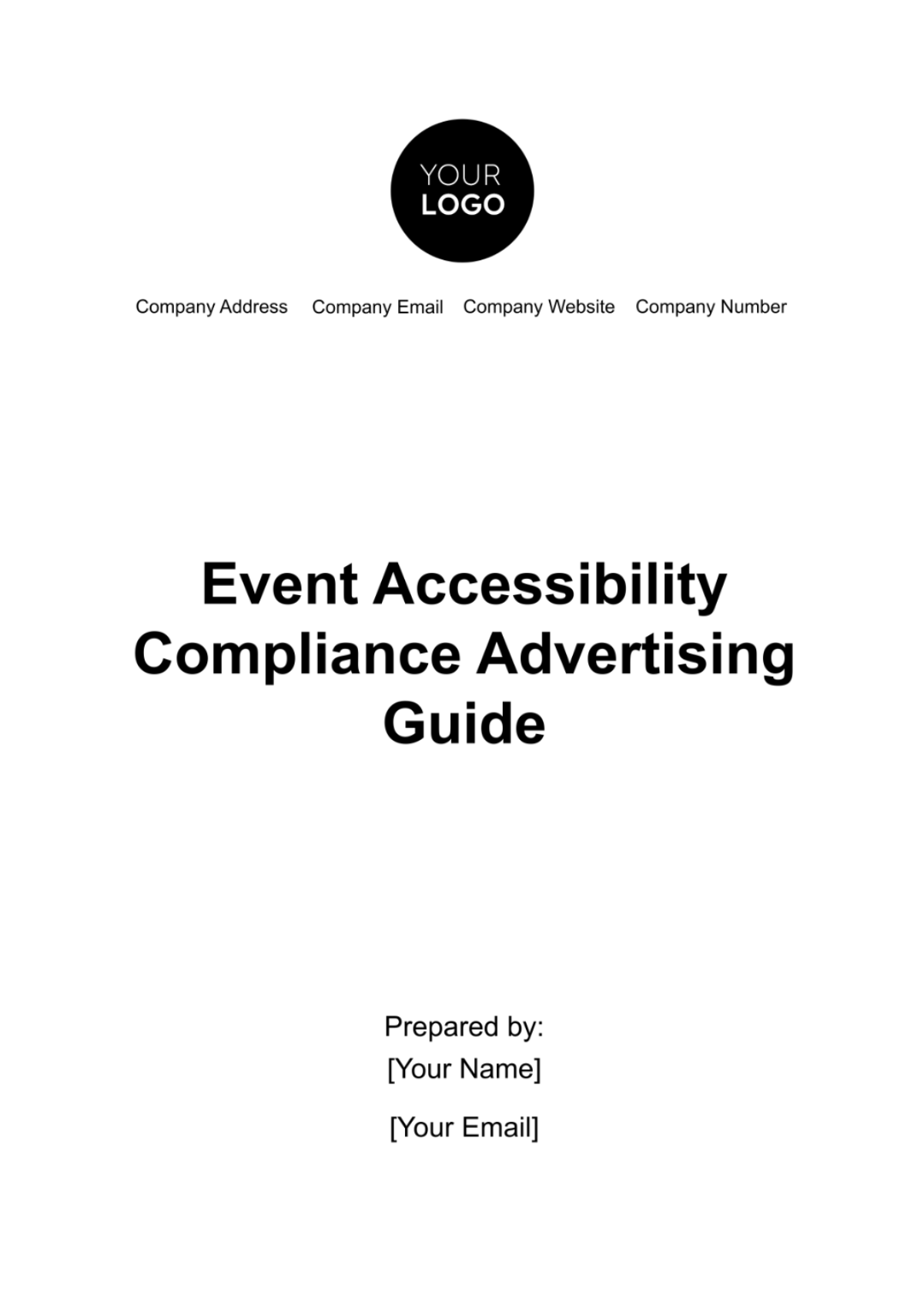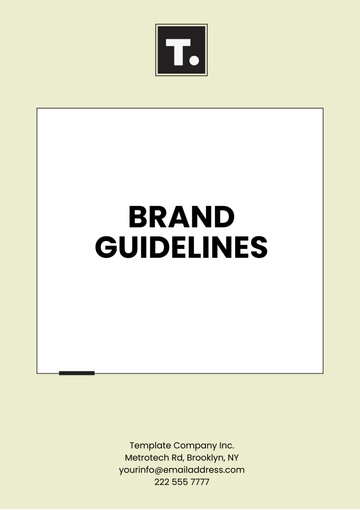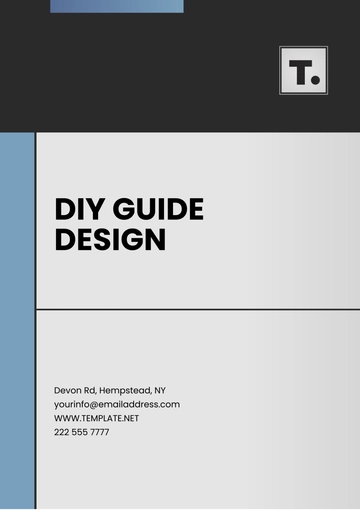Free Event Accessibility Compliance Advertising Guide

I. Introduction
This guide serves as a comprehensive resource for ensuring that event advertising is not only effective but also accessible to all individuals, regardless of their abilities. It aims to help advertisers and event planners understand and implement accessibility standards in their campaigns, ensuring compliance with laws like the Americans with Disabilities Act (ADA) and promoting inclusivity in every aspect of event advertising.
A. The Need for Accessibility: Accessibility in advertising is no longer optional but a necessity. This section explains why making your event advertising accessible is vital for inclusivity and legal compliance.
B. Who This Guide Is For: Tailored for advertising professionals, event planners, marketing teams, and any organization looking to host inclusive events.
C. Navigating the Guide: Instructions on how to use this guide effectively, including tips on applying the information to specific advertising campaigns or events.
II. Understanding Accessibility Compliance
Understanding key accessibility regulations is the first step toward compliance. This section provides a summary of essential laws and guidelines, such as the ADA in the U.S. and the AODA in Canada, that impact event advertising. It highlights the importance of inclusivity in reaching diverse audiences and the legal implications of non-compliance.
A. Overview of ADA and AODA
a. ADA (Americans with Disabilities Act):
The ADA is a civil rights law in the United States that prohibits discrimination against individuals with disabilities in all areas of public life, including jobs, schools, transportation, and all public and private places open to the general public. Key points of the ADA include the requirement for reasonable accommodations in employment and accessibility in public services and communications. This law plays a critical role in ensuring that people with disabilities have the same rights and opportunities as everyone else.
b. AODA (Accessibility for Ontarians with Disabilities Act):
The AODA is a provincial law aiming to create a more accessible province by identifying, removing, and preventing barriers for people with disabilities. The AODA mandates that organizations must follow established standards in accessibility, including in customer service, employment, information and communications, transportation, and design of public spaces. The AODA focuses on full inclusion and participation of people with disabilities in society.
B. Global Accessibility Standards
Global accessibility standards, such as the Web Content Accessibility Guidelines (WCAG), are crucial for creating inclusive digital content. These standards provide a set of recommendations for making web content more accessible to people with disabilities, including visual, auditory, physical, speech, cognitive, language, learning, and neurological disabilities. WCAG is widely adopted internationally and serves as a benchmark for digital accessibility compliance.
Adhering to these global standards is essential for multinational companies and events with an international audience. It ensures that advertising content is accessible to a diverse global audience, enhancing user experience and broadening market reach.
C. Inclusivity in Numbers
According to the World Health Organization, over [1 billion] people, about [15%] of the world's population, experience some form of disability. In the United States alone, the Centers for Disease Control and Prevention (CDC) reports that [26%] of adults have some type of disability. These statistics highlight the significant portion of the population that requires accessible advertising to fully engage with event content.
Ignoring the needs of this substantial demographic can result in missed opportunities for engagement and revenue. In contrast, accessible advertising can tap into this market, enhancing brand loyalty and reputation. Companies that prioritize accessibility in their advertising efforts demonstrate social responsibility and gain a competitive edge in reaching a wider, more diverse audience.
D. Case Studies
One notable case is the [Campaign Name] campaign, a global movement aiming to end discrimination against people with disabilities. This campaign utilized accessible advertising mediums, including captioned videos and inclusive imagery, to reach a broad audience. Another example is [Event Name], which showcased their accessible Xbox Adaptive Controller, resonating powerfully with audiences and receiving widespread acclaim for its inclusive approach.
These case studies illustrate how incorporating accessibility can lead to successful and impactful advertising campaigns. They demonstrate that accessibility not only complies with legal standards but also resonates with audiences, creating powerful and memorable brand experiences. These examples serve as benchmarks for others in the industry to follow, showcasing the potential of inclusive advertising.
E. Consequences of Non-Compliance
Non-compliance with ADA, AODA, or similar regulations can result in significant legal consequences, including lawsuits, fines, and mandatory corrective actions. In the United States, ADA violations can lead to costly litigation, as seen in several high-profile cases against major companies. Similarly, in Canada, failure to comply with AODA standards can result in penalties and legal action.
Non-compliance can severely damage a brand’s reputation. Consumers are more likely to support brands that demonstrate a commitment to inclusivity and accessibility. Neglecting these aspects can lead to negative public perception, loss of customer trust, and decreased market share. It's crucial for companies to recognize that prioritizing accessibility is not only a legal necessity but also a key component of responsible and ethical business practices.
III. Accessible Advertising Content Creation
Creating accessible visual content is crucial in event advertising. This section provides guidelines for ensuring that all visual elements, such as color contrast, text size, and image descriptions, meet accessibility standards. It also covers the importance of considering various visual impairments in the design process to ensure that advertisements are perceivable by everyone.
A. Color and Contrast: Best practices for choosing colors and contrasts that are easily distinguishable.
B. Text and Fonts: Guidelines on font size, type, and spacing for readability.
C. Image Descriptions: Techniques for writing effective alternative text for images.
D. Design Considerations: Discussing specific design considerations for visual impairments, including examples of successful ad campaigns that effectively used accessible design principles.
E. Content Strategies: Strategies for creating content that resonates with people with different types of disabilities, using examples of campaigns that have successfully integrated these strategies.
IV. Accessible Digital Advertising Platforms
Ensuring that your event's website and digital ads are accessible is a critical aspect of compliance. This section delves into the Web Content Accessibility Guidelines (WCAG), providing practical steps to ensure that digital platforms are navigable, understandable, and operable for all users, including those with disabilities
A. WCAG Principles
The WCAG is built around four foundational principles, ensuring web content is accessible to a wider range of people with disabilities. These principles are Perceivable, Operable, Understandable, and Robust. Perceivable means that users must be able to perceive the information being presented; it cannot be invisible to all of their senses. Operable ensures that users can operate the interface and that the interface does not require interaction that a user cannot perform.
Understandable means that users must be able to understand the information as well as the operation of the user interface; the content or operation cannot be beyond their understanding. Robust refers to the need for content to be robust enough that it can be interpreted reliably by a wide variety of user agents, including assistive technologies. By adhering to these principles, web content becomes accessible to people with a range of hearing, movement, sight, and cognitive ability.
B. Checklist for Website Accessibility
To ensure website compliance with WCAG, a detailed checklist is vital. This checklist should include: ensuring text alternatives ("alt text") for non-text content, providing captions and other alternatives for multimedia, creating content that can be presented in different ways without losing information, ensuring easy navigation and user interface components, and making text content readable and understandable.
The checklist should also ensure robustness, so content can be reliably interpreted by a wide variety of user agents, including assistive technologies. Other items include checking color contrast ratios, ensuring all functionality is available from a keyboard for users who cannot use a mouse, providing users enough time to read and use content, and not designing content in a way that is known to cause seizures or physical reactions.
C. Tools for Testing Digital Accessibility
Several tools and software solutions can assist in testing websites and digital advertising for accessibility compliance. Popular tools include WAVE (Web Accessibility Evaluation Tool), which provides visual feedback about the accessibility of web content; Axe, a browser extension for checking accessibility; and Google Lighthouse, an open-source, automated tool for improving the quality of web pages, including accessibility checks.
Other useful tools include Color Contrast Analyzers, which help ensure that colors on a website have sufficient contrast, and screen reader software like JAWS, NVDA, and VoiceOver, which can be used to test how a website is read by screen readers. These tools are essential in identifying areas where a website or digital ad might not meet accessibility standards, allowing for necessary modifications.
D. Best Practices for Social Media
When creating content for social media platforms like Facebook, Twitter, and Instagram, it’s important to follow accessible best practices. This includes adding alt text to images, using captions and transcripts for video content, ensuring color contrast is sufficient for text on images, using hashtags judiciously, and avoiding the use of flashing or strobing content that could trigger seizures.
Further best practices include writing clear and concise posts, using CamelCase for multi-word hashtags, providing descriptive link text rather than URLs, and ensuring videos start with a clear introduction. These practices not only make social media content accessible to those with disabilities but also enhance the overall user experience, making content more engaging and understandable for a broader audience.
E. Case Studies
Digital Accessibility in Action: Case studies of websites and digital campaigns that excellently adhere to WCAG standards.
Leveraging Technology for Accessibility: How to leverage emerging technologies, like screen readers and voice-assistive devices, in digital advertising platforms for enhanced accessibility.
V. Physical Event Accessibility Considerations
Selecting an accessible venue is just as important as creating accessible advertising content. This section offers a comprehensive checklist for ensuring physical accessibility at event venues, including wheelchair access, sign language interpretation, and considerations for other disabilities. It also addresses the creation of accessible print materials for the event..
Venue Selection Criteria: Key factors to consider when choosing an accessible venue.
Sign Language and Captioning Services: How to incorporate sign language interpreters and real-time captioning in your event.
Accessible Print Materials: Guidelines for creating brochures, flyers, and other print materials that are accessible to all attendees.
Real-world Examples: Showcasing real-world examples of events that excelled in physical accessibility, including layout adaptations and services provided.
Innovations in Physical Accessibility: Discussing innovative solutions in physical accessibility used in events, like advanced sign language interpretation services and sensory-friendly environments.
VI. Training and Resources
Proper training of staff on accessibility compliance is essential. This section highlights the importance of educating your team on the best practices for inclusive communication and the basics of accessibility law. It also provides a curated list of resources, tools, and services to aid in creating accessible content.
Training Modules: Outline of essential training modules for staff.
Resource Library: A compilation of books, articles, and online resources on accessibility.
Expert Contacts: A list of industry experts and organizations specializing in accessibility.
Workshops and Seminars: Information on upcoming workshops and seminars on accessibility compliance.
Interactive Training Programs: Highlighting the importance of interactive and continuous training programs with examples of successful training modules.
Collaboration with Experts: Emphasizing the benefits of collaborating with accessibility experts and organizations to enhance staff training and resource development.
VII. Monitoring and Compliance Checks
Establishing a routine for auditing your advertising content for compliance is critical. This section emphasizes the need for regular accessibility audits and the implementation of feedback mechanisms to gather insights from attendees on accessibility. It provides a framework for continuous improvement in accessibility practices.
Audit Schedule: A proposed schedule for regular accessibility audits of advertising materials.
Feedback Collection: Methods for collecting and analyzing feedback from event attendees.
Continuous Improvement Plan: Strategies for implementing improvements based on audit findings and feedback.
Effective Auditing Practices: Sharing best practices for conducting effective and thorough accessibility audits of advertising content.
Case Studies of Feedback Implementation: Examples of how feedback from attendees has been successfully implemented to improve event accessibility in past events.
VIII. Legal and Ethical Considerations
This section provides an overview of the legal implications of non-compliance with accessibility standards in advertising. It emphasizes the ethical responsibility of advertisers to go beyond legal requirements, promoting a culture of inclusivity and equal access for all individuals.
Legal Case Studies: Examples of legal cases related to accessibility non-compliance.
Beyond Compliance: Discussion on ethical considerations and corporate social responsibility.
Advocacy and Awareness: The role of advertisers in advocating for and raising awareness about accessibility.
Navigating the Ethical Landscape: Discussion on the ethical landscape of accessibility in advertising, including dilemmas and best practices for ethical decision-making.
Building an Inclusive Brand Image: How focusing on accessibility in advertising can build a more inclusive brand image and foster customer loyalty.
IX. Conclusion
By embracing these practices, we not only comply with legal standards but also open our events to a wider, more diverse audience. This commitment to accessibility reflects a deeper understanding of our community's diverse needs, showcasing [Your Company Name]'s dedication to being a leader in inclusive marketing. Let's move forward with the knowledge and tools provided in this guide, committed to making every event an opportunity for everyone to connect, participate, and enjoy.
- 100% Customizable, free editor
- Access 1 Million+ Templates, photo’s & graphics
- Download or share as a template
- Click and replace photos, graphics, text, backgrounds
- Resize, crop, AI write & more
- Access advanced editor
Introducing Template.net's Event Accessibility Compliance Advertising Guide Template, your go-to resource for ensuring inclusivity in event promotions. Fully customizable and editable in our Ai Editor Tool, this template enables businesses to create advertising campaigns that meet accessibility standards. Reach a wider audience and demonstrate commitment to diversity and inclusion with ease. Simplify your advertising process and enhance your brand reputation effortlessly.





























